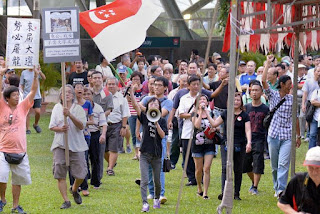Author: Michael Raska, RSIS, 1 May 2014
Since its inception as a small city-state, Singapore has grappled with insecurity and strategic uncertainty. Traditionally, small states have experienced considerable limitations in balancing their security needs and strategic ambitions with policies directed at maintaining economic growth and social stability.
These challenges have become even more acute within the context of East Asia’s changing and progressively complex security environment. East Asia’s strategic template is shifting toward a mix of asymmetric anti-access/area-denial threats, low-high intensity conventional conflicts, and a range of non-traditional security challenges. Accordingly, Singapore must devise an adaptive defence posture that takes into account factors such as its lack of strategic depth, resource limitations, changing strategic priorities, as well as external factors, such as increasing geostrategic competition between great powers in the region.
Unfortunately, the range of policy options available to small states seeking to overcome their external as well as internal geostrategic limitations is not particularly wide.
Small states have often sought to offset their geostrategic vulnerabilities by strengthening their alliances with great powers — a form of external balancing, in which a great power defends the interests of a small state and ensures at least partial extended deterrence. The downside of this route is that it potentially leads to costly diplomatic attachments and long-term policy constraints. Accordingly in Singapore’s case, external balancing has served as a hedging strategy, allowing Singapore to view both China and
the US as potentially useful strategic partners, but not allies.
Alternatively, other small states have pursued military self-reliance by maximising their internal resources. However, the potential payoffs from internal balancing are limited. Small states, especially those seeking to counterbalance their ‘smallness’ by increasing levels of military expenditure and production, invariably find that the ancillary economic and social costs associated with pursuing self-reliance are high, if not crippling.
Other foreign policy postures pursued by small states include ‘defensive isolation’, neutrality, and adaptation measures like ‘non-offensive defence’. These notwithstanding, the prevailing structure of the anarchic international system of self-help has traditionally forced most small states to adopt a defensive posture based on a mix of both external and internal balancing.
The magnitude, intensity, and impact of ‘mixed’ balancing depends on a number of factors such as the level of the small state’s economic and social development, its geographical proximity to conflict, the cohesion of its population, and, perhaps most importantly of all, its relationship with and importance to great powers.
However, small states are not necessarily weak states.
Singapore is often viewed as a small country. This is certainly the case when it is compared to its neighbours: Indonesia, for instance, has a huge archipelago and a population of 246 million, compared to Singapore’s 5.5 million. Yet Singapore’s 2013 defence budget of $12 billion is considerably larger than Indonesia’s budget of $7.9 billion. In international relations, it is the relative strength of a state which matters, rather than its size.
Singapore’s traditional security paradigm has historically been based on deterrence, and swift and decisive victory if deterrence fails. Technology plays a large part in Singapore’s security apparatus. Singapore views the integration of advanced military technologies as a primary force multiplier that is capable of providing it with an edge when it comes to coping with both existing and future threats.
But technology is only a part of Singapore’s deterrence strategy. Its deterrent posture is not exclusively military-strategic posture, but involves defence diplomacy with select strategic partners.
Singapore’s military management capacity when it comes to planning, organising, leading, and controlling armed forces and their supporting systems to adopt particular innovations has been equally important.
Accordingly, Singapore has sought to build a relatively advanced, reliable and cost-effective industrial base capable of developing and integrating selective defence technologies, niche products and services. These measures, together with the combat proficiency and training of the Singapore Armed Forces (SAF), have enabled Singapore’s military to pursue innovation at the operational level over the past decade.
Indeed, with Singapore’s ongoing military modernisation drive, SAF aims to become a ‘smart’ or networked army capable of a range of operations in peacetime, as well as wartime. This is under the conceptual umbrella of ‘3G or third generation military transformation’ that began in 2004. By 2030, the SAF envisions the integration of unmanned precision, early warning, intelligence, surveillance and reconnaissance systems. Most importantly, the SAF looks to achieve an unprecedented degree of interoperability between its army, navy, and air force platforms.
This continuity and change in Singapore’s defence strategy are directed at addressing the growing complexity of East Asian security dilemmas, particularly with respect to the deepening territorial disputes and potential crises over
islands in the South China Sea and East China Sea. The convergence of these security threats, along with the growing adoption of advanced military platforms and technologies by Singapore’s neighbours, increases the SAF’s operational requirements. The SAF will have to strike a balance between preserving tried and tested strategies and structures with finding innovative operational concepts and organisational structures in preparation for multi-level conflicts. The key dilemma facing Singaporean defence planners is the question how to build a force and doctrine capable of dealing simultaneously with current security threats, while anticipating future challenges.
Michael Raska is Research Fellow at the S. Rajaratnam School of International Studies, Nanyang Technological University, Singapore.

































